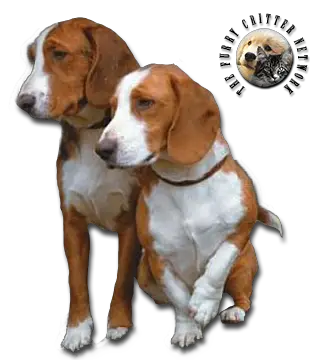Breed Standard
Head: Lightweight. Slightly domed skull. Pronounced stop. Straight nosebridge. Darkly pigmented lips.
Ears: Set on fairly far back, wide, long, hanging flat.
Eyes: Medium in size. Dark brown. Edge of eyelids pigmented.
Body: Robust. Muscular neck. Long, broad chest. Moderate tuck-up. Straight, well-muscled back. Croup not too long, slightly sloping.
Tail: Long, covered with dense hair (brush), hanging loosely.
Hair: 3 to 5 cm long (1 to 2 in), straight, firm, very dense. Dense undercoat.
Coat: Dark reddish-fawn, may be slightly smoky (black tips), or black and tan. Also allowed: light reddish-fawn or black with limited or indistinct tan markings. White spots undesirable.
Size: Dog: 37 to 38 cm. (14.5-15 in).Bitch: 36 to 37 cm. (14-14.5 in).
Weight: Approx. 20 kg. (44 lb).
History
In 1896, the Deutschen Bracken Club, encompassing all of the local types of Bracke in northwest Germany, was formed in Olpe. The breeds were merged in 1900 as one breed and were officially designated Deutsche Bracke. This breed was formerly called by a variety of old regional names such as "Olpe Bracke", "Sauerländer Bracke" and "Westphalian Bracke", and other local types now blended into one breed. The only breeds of Bracke in the area today are the German Hound and the Westphalian Dachsbracke. The Westphalian Dachsbracke is a short-legged dog, possibly a cross of a Bracke with the Dachshund.
Hunting with the Bracke in early times was done with hunters on horses following the hounds, as developed by the ancient Celts chasing deer, and modern-day fox hunters. Another sport, developed in the 16th century, did not require the expense of horses and big kennels, and made use of firearms, called Brackade. Hounds hunting this way tenaciously follow the game while voicing cries that communicate to the hunter as to where the dog is and what type of game the dog is following. Today, the Deutsche Bracke is usually used to hunt deer, but also rabbits and fox. Often, it is hunted singly as a leash hound, to hunt on smaller areas. The space needed to hunt a pack of hounds is described by the breed club as a minimum area of 1,000 ha (2471 acres). Related to the hunting with Bracke is the use of horns to communicate with the dogs, a custom that is continued today.
The German Hound was recognized by the Verband für das Deutsche Hundewesen (German Kennel Club) through the Deutschen Bracken Club was formed in 1896 and continues today, and oversees breeding and hunt testing, as well as preserving traditions of Bracke hunting. The German Hound was the first Bracke to be registered as a distinct breed, in 1900. and by the Federation Cynologique Internationale as breed number 299 in Group 6 (Scenthounds), Section 1.3 (Small hounds). Of the major kennel clubs in the English-speaking world, only the United Kennel Club in the US recognises the German Hound, in its Scenthound Group. The German Hound also may be recognised by any of the many minor registries, rare breed groups, hunting clubs, and internet registry businesses under its original name, discarded antique names, translations of the name, or variations on the name. The German Hound is strictly a hunting dog, and seldom seen outside its native country. Outside the home country, purchasers of dogs represented as German Hound should research the dog's background, especially if it is registered with one of the minor clubs that require little to no documentation before accepting a dog or litter for registration.






